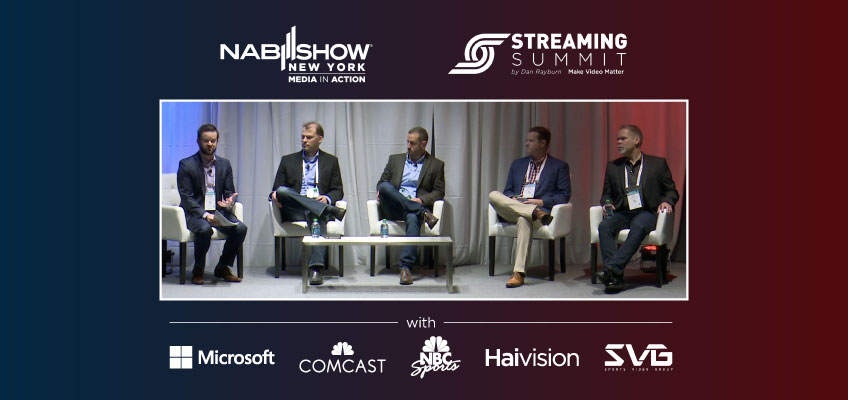In October, at NAB NY, the Streaming Summit hosted a panel titled “Low Latency Video Delivery Using SRT.” The panel featured an impressive list of speakers, including broadcast video streaming experts from Microsoft, Comcast, NBC Sports, and Haivision. Moderated by Brandon Costa from Sports Video Group, these speakers explored their experiences using the open source SRT protocol in some of the most demanding environments.
Sitting in the crowd, as a Haivision employee, I must admit that I still managed to be surprised by some of the answers from the panelists on their use of the low-latency SRT protocol. I would highly recommend that you take a moment to watch the panel. But if you want a little preview beforehand, here is an overview of what I learned watching the discussion.
SRT not only delivers high quality video, but top-tier quality.
It’s fairly obvious from the names on the panel that SRT must be good for broadcast. Comcast and Microsoft aren’t going to be using SRT simply to stream to themselves while riding the train. However, there is nothing quite like hearing about SRT in action from some of the best in video streaming.
Pete Thordarson, from Microsoft, describes SRT as “near-fibre quality” at 24:30 of the video. Chris Connolly of NBC Sports praised SRT’s low latency, as it was a reliable option outside of a dedicated network. Comcast’s Joe Mancini explains how SRT is fantastic for their point-to-multipoint streaming, which is something that Comcast Tech Solutions is incredibly dependent upon, and requires SRT’s reliability.
As a sports fan, it was exciting to hear how NBC Sports was leveraging SRT for major sporting events like the World Cup and the Olympics. Even more exciting, however, was listening to Chris Connolly describe how NBC Sports was using SRT to improve their sports broadcast in between these major events.
SRT is really easy to use
You may have read the articles detailing how “easy” it is to set up SRT streams. And while it may sound like a pretty straightforward process, it’s difficult not to take with a grain of salt. Especially, when the developers of a video streaming protocol are the ones who tell you how easy it is to use. Turns out, we’re not the only ones who think this.
Pete from Microsoft, describes it the clearest when talking about deploying an SRT-enabled device. “We can literally put it in the hands of a producer that isn’t even an engineer and he can go out, plug in to an internet connection… And we’re up, on the air, with fibre-quality, or near-fibre quality transmission.”
Pete also dives into some of the more technical advantages of SRT. It can slip through a firewall without having to spend a whole bunch of time creating workarounds. This takes yet another step out of the video streaming process, saving time and money.
Joe Mancini, of Comcast, walks the audience through their linear transport service workflow during this panel. And when going through their workflow, there are two things that really stand out for me. The first, is that SRT is an incredibly integral part of what they do. The second is that the SRT video streaming protocol simplifies the video transport process by a great deal.
SRT stands up to the most rigorous of security demands
Security is paramount in 2019. After 2018’s numerous security and privacy blunders in the tech world, companies are not taking any chances.
Piracy is a real threat for broadcasters. For companies like Comcast, their content is expensive. Any threat to their content, and content they are transporting from affiliates, is a real threat to their bottom line. And Joe Mancini explains, at 12:30 of the panel, why Comcast relies on SRT.
This is even more pronounced in the world of live sports, when major events tend to be highly pirated. Take the 2017 McGregor/Mayweather fight, which was streamed illegally by almost 3 million viewers. And these events still have to be aired live with as low latency as possible, to avoid any spoilers. NBC’s Chris Connolly describes how they use SRT to get their content not only to their broadcast production centers, but back to their venues, as it is low latency, and highly secure.
Video broadcasters are using SRT to plan for the future
Broadcasters are planning their futures with SRT in mind. This is one of the best endorsements that the open source video streaming protocol could have received. Joe, from Comcast, speaks about how Comcast is growing, with more high-quality content. They are looking into replacing some of their older infrastructure with SRT in order to handle the increasing amount of high-quality content for which they are responsible.
Pete Thordarson also shows the audience a video featuring Jeff Tyler, Microsoft Production Studios’ Digital Media Experience Lead, showing Microsoft’s One Stream project. This project is designed to move workflows to Azure, and combining them to make video streaming at their events more efficient and higher quality. Where SRT fits into the puzzle is their goal to implement “flexible and robust IP video solutions.”
As someone who has been immersed in SRT-related stories since my arrival at Haivision, I found it incredibly enlightening to see some of the industries’ biggest players demonstrate how they are leveraging this open-source protocol.

